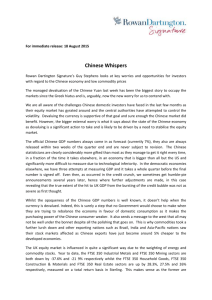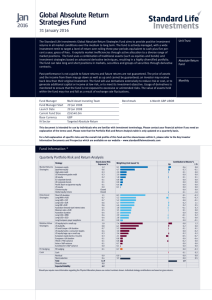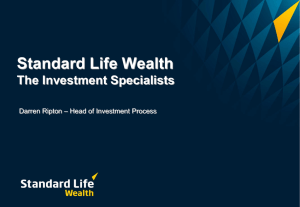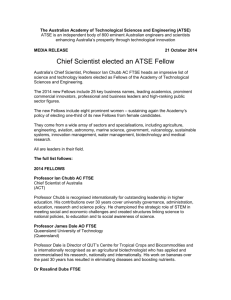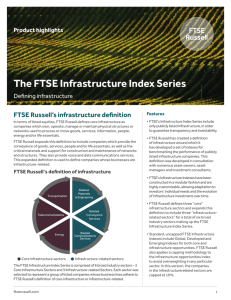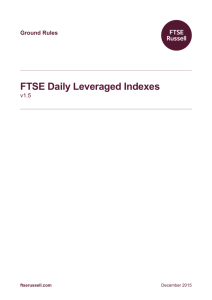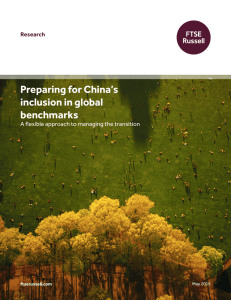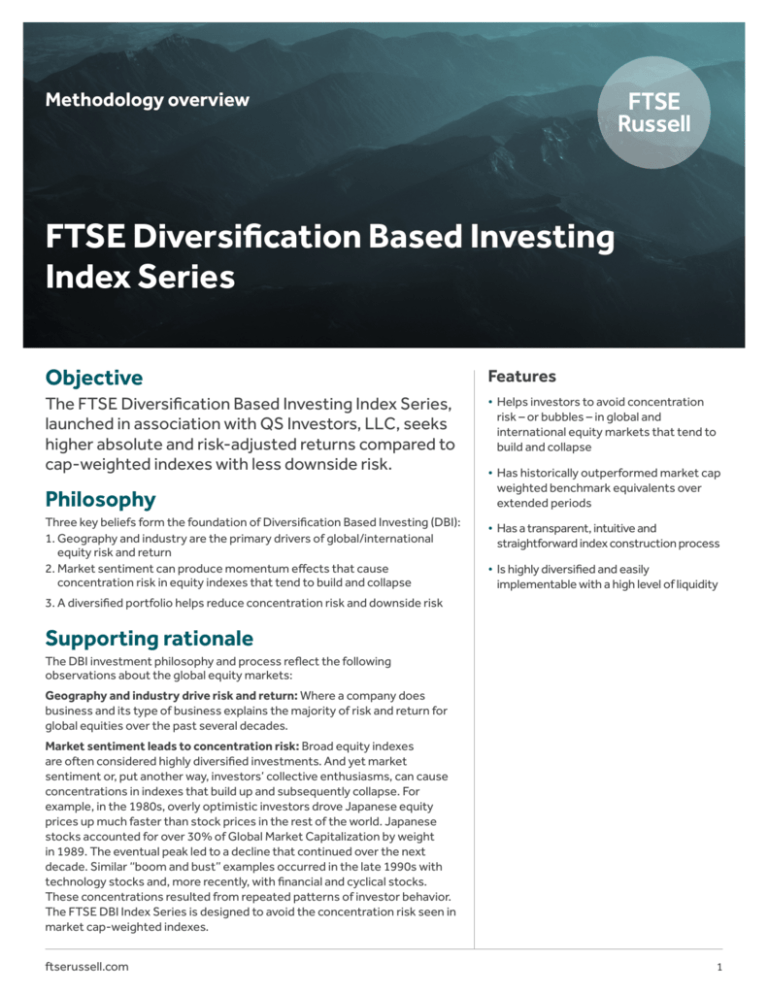
Methodology overview
FTSE Diversification Based Investing
Index Series
Objective
Features
The FTSE Diversification Based Investing Index Series,
launched in association with QS Investors, LLC, seeks
higher absolute and risk-adjusted returns compared to
cap-weighted indexes with less downside risk.
• Helps investors to avoid concentration
risk – or bubbles – in global and
international equity markets that tend to
build and collapse
Philosophy
Three key beliefs form the foundation of Diversification Based Investing (DBI):
1. G
eography and industry are the primary drivers of global/international
equity risk and return
2. M
arket sentiment can produce momentum effects that cause
concentration risk in equity indexes that tend to build and collapse
• Has historically outperformed market cap
weighted benchmark equivalents over
extended periods
• Has a transparent, intuitive and
straightforward index construction process
• Is highly diversified and easily
implementable with a high level of liquidity
3. A
diversified portfolio helps reduce concentration risk and downside risk
Supporting rationale
The DBI investment philosophy and process reflect the following
observations about the global equity markets:
Geography and industry drive risk and return: Where a company does
business and its type of business explains the majority of risk and return for
global equities over the past several decades.
Market sentiment leads to concentration risk: Broad equity indexes
are often considered highly diversified investments. And yet market
sentiment or, put another way, investors’ collective enthusiasms, can cause
concentrations in indexes that build up and subsequently collapse. For
example, in the 1980s, overly optimistic investors drove Japanese equity
prices up much faster than stock prices in the rest of the world. Japanese
stocks accounted for over 30% of Global Market Capitalization by weight
in 1989. The eventual peak led to a decline that continued over the next
decade. Similar “boom and bust” examples occurred in the late 1990s with
technology stocks and, more recently, with financial and cyclical stocks.
These concentrations resulted from repeated patterns of investor behavior.
The FTSE DBI Index Series is designed to avoid the concentration risk seen in
market cap-weighted indexes.
ftserussell.com
1
FTSE Russell
FTSE Diversification Based Investing Index Series
Index methodology
Underpinnings:
To achieve the goal of maximum diversification across countries and
industries, DBI groups stocks into risk themes or “clusters” according to their
correlations and then equal-weights the clusters. The result is a diversified
portfolio structured according to risk themes in the market based on
correlations rather than market cap weights. This is achieved through a four
step process:
Macro and Behavioral Inefficiency DBI
seeks to take advantage of macro and
behavioral inefficiencies in global and
international equity markets by developing
a diversified exposure to macro risk factors.
DBI uses analysis of country and industry
correlations to create an index that is highly
diversified across major risk exposures in
the market. It does not engage in stock
selection. Behavioral inefficiencies, such
as the inclination towards herding, can
arise when investors face uncertainty over
the likely impact of traditional drivers of
country and industry allocation decisions.
These drivers include:
Step 1:
Step 2:
Step 3:
Step 4:
Partition the
universe into key
risk exposures
Cluster highly
correlated risk
exposures
Weight for
optimal
diversification
Implement to
dynamically capture
market shifts
Methodology
Step 1: Partition the investment universe
The objective of this step is to identify stocks with common risk drivers. We
do this by dividing the investment universe from each relevant FTSE Index
by country and industry into “risk units.”
Step 2: Cluster highly correlated risk units
The objective of this step is to identify the key risk themes or drivers in
equity markets. We use correlation analysis to group highly correlated risk
units into “clusters” which represent risk themes or exposures in equity
markets. Risk Units are clustered such that the correlation of risk units
within clusters is high and the correlation between clusters is low, thereby
seeking a high level of diversification across risk themes.
Step 3: Weight for optimal diversification
The objective of this step is to develop a diversified exposure to key drivers
of risk in equity markets. Our approach is to equally weight all clusters
and then equally weight the risk units within each cluster. This allows us to
systematically give greater weight to good diversifiers and relatively less
weight to poor diversifiers.
Step 4: Implementation
The objective of this step is to capture structural changes in correlations
with low turnover. To do this, the risk clusters are updated annually to
ensure the portfolio reflects shifts in correlations among risk units, and the
indexes are rebalanced quarterly to maintain diversification. Turnover is
therefore minimized to keep transaction and market impact costs low.
Methodology overview
Monetary policy: The future level of interest
rates, potential and implemented asset
purchases as well as other actions by central
banks is uncertain as is their impact over the
near- and medium-term. Investors struggle
with these issues when evaluating the value
of different parts of the market and the
impact on economic growth as well as the
effectiveness of policy actions.
Fiscal policy: Similar to monetary policy,
fiscal stimulus or austerity is debated,
enacted and modified over the mediumterm
and subject to disagreement by policy
makers as well as investors. It takes years to
assess the impact of fiscal policy often with
uneven and contradictory economic data
that is released on an infrequent basis.
Regulatory policy: Legislative agendas
and reaction to market events can have
a large impact on perceived and actual
country competitiveness as well as
industry profitability and business strategy.
These changes are often debated over a
multi-year time frame and the impact of
legislation is uncertain.
Data definitions available from ftserussell.com.
2
FTSE Diversification Based Investing Index Series
FTSE Russell
For more information about our indexes, please visit ftserussell.com.
© 2015 London Stock Exchange Group companies.
London Stock Exchange Group companies includes FTSE International Limited (“FTSE”), Frank Russell Company (“Russell”),
MTS Next Limited (“MTS”), and FTSE TMX Global Debt Capital Markets Inc (“FTSE TMX”). All rights reserved.
“FTSE®”, “Russell®”, “MTS®”, “FTSE TMX®” and “FTSE Russell” and other service marks and trademarks related to the FTSE or
Russell indexes are trademarks of the London Stock Exchange Group companies and are used by FTSE, MTS, FTSE TMX and
Russell under licence.
All information is provided for information purposes only. Every effort is made to ensure that all information given in this
publication is accurate, but no responsibility or liability can be accepted by the London Stock Exchange Group companies nor
its licensors for any errors or for any loss from use of this publication.
Neither the London Stock Exchange Group companies nor any of their licensors make any claim, prediction, warranty or
representation whatsoever, expressly or impliedly, either as to the results to be obtained from the use of the FTSE Russell
Indexes or the fitness or suitability of the Indexes for any particular purpose to which they might be put.
The London Stock Exchange Group companies do not provide investment advice and nothing in this document should be
taken as constituting financial or investment advice. The London Stock Exchange Group companies make no representation
regarding the advisability of investing in any asset. A decision to invest in any such asset should not be made in reliance on any
information herein. Indexes cannot be invested in directly. Inclusion of an asset in an index is not a recommendation to buy, sell
or hold that asset. The general information contained in this publication should not be acted upon without obtaining specific
legal, tax, and investment advice from a licensed professional.
No part of this information may be reproduced, stored in a retrieval system or transmitted in any form or by any means,
electronic, mechanical, photocopying, recording or otherwise, without prior written permission of the London Stock Exchange
Group companies. Distribution of the London Stock Exchange Group companies’ index values and the use of their indexes to
create financial products require a licence with FTSE, FTSE TMX, MTS and/or Russell and/or its licensors.
The Industry Classification Benchmark (“ICB”) is owned by FTSE. FTSE does not accept any liability to any person for any loss
or damage arising out of any error or omission in the ICB.
Past performance is no guarantee of future results. Charts and graphs are provided for illustrative purposes only. Index returns
shown may not represent the results of the actual trading of investable assets. Certain returns shown may reflect backtested performance. All performance presented prior to the index inception date is back-tested performance. Back-tested
performance is not actual performance, but is hypothetical. The back-test calculations are based on the same methodology
that was in effect when the index was officially launched. However, back-tested data may reflect the application of the index
methodology with the benefit of hindsight, and the historic calculations of an index may change from month to month based
on revisions to the underlying economic data used in the calculation of the index.
Methodology overview
3
FTSE Russell
FTSE Diversification Based Investing Index Series
About FTSE Russell
FTSE Russell is a leading global provider of benchmarking, analytics and data
solutions for investors, giving them a precise view of the market relevant to
their investment process. A comprehensive range of reliable and accurate
indexes provides investors worldwide with the tools they require to measure
and benchmark markets across asset classes, styles or strategies.
FTSE Russell index expertise and products are used extensively by
institutional and retail investors globally. For over 30 years, leading asset
owners, asset managers, ETF providers and investment banks have chosen
FTSE Russell indexes to benchmark their investment performance and create
ETFs, structured products and index-based derivatives.
FTSE Russell is focused on applying the highest industry standards in index
design and governance, employing transparent rules-based methodology
informed by independent committees of leading market participants. FTSE
Russell fully embraces the IOSCO Principles and its Statement of Compliance
has received independent assurance. Index innovation is driven by client
needs and customer partnerships, allowing FTSE Russell to continually
enhance the breadth, depth and reach of its offering.
FTSE Russell is wholly owned by London Stock Exchange Group.
For more information, visit www.ftserussell.com.
About QS Investors, LLC
QS Investors, LLC is an independent investment firm providing asset
management and advisory services to a diverse array of institutional clients.
QS Investors has focused over the last 10 years on pioneering approaches to
integrating quantitative and qualitative investment insights and dynamically
weighting key market drivers a cross a diverse spectrum of strategies
including global tactical asset allocation, global and US equities.
For more information please visit: www.qsinvestors.com.
To learn more, visit www.ftserussell.com; email index@russell.com, info@ftse.com;
or call your regional Client Service Team office:
EMEA
North America
Asia-Pacific
+44 (0) 20 7866 1810
+1 877 503 6437
Hong Kong +852 2164 3333
Tokyo +81 3 3581 2764
Sydney +61 (0) 2 8823 3521
Methodology overview
4


